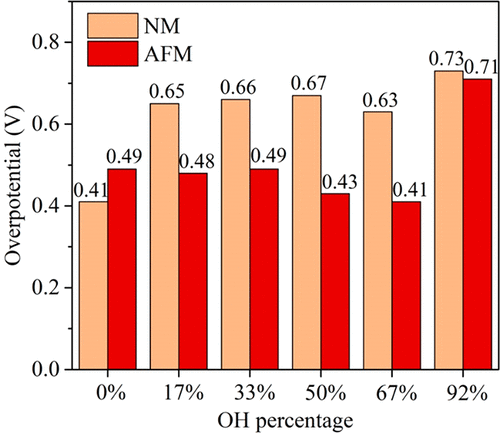当前位置:
X-MOL 学术
›
J. Phys. Chem. C
›
论文详情
Our official English website, www.x-mol.net, welcomes your
feedback! (Note: you will need to create a separate account there.)
Anti-Ferromagnetic RuO2: A Stable and Robust OER Catalyst over a Large Range of Surface Terminations
The Journal of Physical Chemistry C ( IF 3.3 ) Pub Date : 2022-01-16 , DOI: 10.1021/acs.jpcc.1c08700 Qiuhua Liang 1, 2 , Anja Bieberle-Hütter 1, 3 , Geert Brocks 2, 3, 4
The Journal of Physical Chemistry C ( IF 3.3 ) Pub Date : 2022-01-16 , DOI: 10.1021/acs.jpcc.1c08700 Qiuhua Liang 1, 2 , Anja Bieberle-Hütter 1, 3 , Geert Brocks 2, 3, 4
Affiliation

|
Rutile RuO2 is a prime catalyst for the oxygen evolution reaction (OER) in water splitting. Whereas RuO2 is typically considered to be non-magnetic (NM), it has recently been established as being anti-ferromagnetic (AFM) at room temperature. The presence of magnetic moments on the Ru atoms signals an electronic configuration that is markedly different from what is commonly assumed, the effect of which on the OER is unknown. We use density functional theory (DFT) calculations within the DFT+U approach to model the OER process on NM and AFM RuO2(110) surfaces. In addition, we model the thermodynamic stability of possible O versus OH terminations of the RuO2(110) surface and their effect on the free energies of the OER steps. We find that the AFM RuO2(110) surface gives a consistently low overpotential in the range 0.4–0.5 V, irrespective of the O versus OH coverage, with the exception of a 100% OH-covered surface, which is, however, unlikely to be present under typical OER conditions. In contrast, the NM RuO2(110) surface gives a significantly higher overpotential of ∼0.7 V for mixed O/OH terminations. We conclude that the magnetic moment of RuO2 supplies an important contribution to obtaining a low overpotential and to its insensitivity to the exact O versus OH coverage of the (110) surface.
中文翻译:

反铁磁RuO2:在大范围的表面端接上稳定而强大的OER催化剂
金红石RuO 2是水分解中析氧反应(OER)的主要催化剂。尽管 RuO 2通常被认为是非磁性 (NM),但它最近已被确定为在室温下是反铁磁 (AFM)。Ru原子上磁矩的存在表明电子配置与通常假设的明显不同,其对OER的影响尚不清楚。我们在 DFT+ U方法中使用密度泛函理论 (DFT) 计算来模拟 NM 和 AFM RuO 2 (110) 表面上的 OER 过程。此外,我们模拟了可能的 O 与 RuO 2的 OH 末端的热力学稳定性(110)表面及其对OER步骤自由能的影响。我们发现 AFM RuO 2 (110) 表面在 0.4-0.5 V 范围内提供始终如一的低过电势,无论 O 与 OH 覆盖率如何,但 100% OH 覆盖的表面除外,然而,这是不太可能的在典型的 OER 条件下存在。相比之下,NM RuO 2 (110) 表面对于混合的 O/OH 末端给出了显着更高的~0.7 V 的过电势。我们得出结论,RuO 2的磁矩对获得低过电势及其对 (110) 表面的精确 O 对 OH 覆盖率不敏感提供了重要贡献。
更新日期:2022-01-27
中文翻译:

反铁磁RuO2:在大范围的表面端接上稳定而强大的OER催化剂
金红石RuO 2是水分解中析氧反应(OER)的主要催化剂。尽管 RuO 2通常被认为是非磁性 (NM),但它最近已被确定为在室温下是反铁磁 (AFM)。Ru原子上磁矩的存在表明电子配置与通常假设的明显不同,其对OER的影响尚不清楚。我们在 DFT+ U方法中使用密度泛函理论 (DFT) 计算来模拟 NM 和 AFM RuO 2 (110) 表面上的 OER 过程。此外,我们模拟了可能的 O 与 RuO 2的 OH 末端的热力学稳定性(110)表面及其对OER步骤自由能的影响。我们发现 AFM RuO 2 (110) 表面在 0.4-0.5 V 范围内提供始终如一的低过电势,无论 O 与 OH 覆盖率如何,但 100% OH 覆盖的表面除外,然而,这是不太可能的在典型的 OER 条件下存在。相比之下,NM RuO 2 (110) 表面对于混合的 O/OH 末端给出了显着更高的~0.7 V 的过电势。我们得出结论,RuO 2的磁矩对获得低过电势及其对 (110) 表面的精确 O 对 OH 覆盖率不敏感提供了重要贡献。






























 京公网安备 11010802027423号
京公网安备 11010802027423号